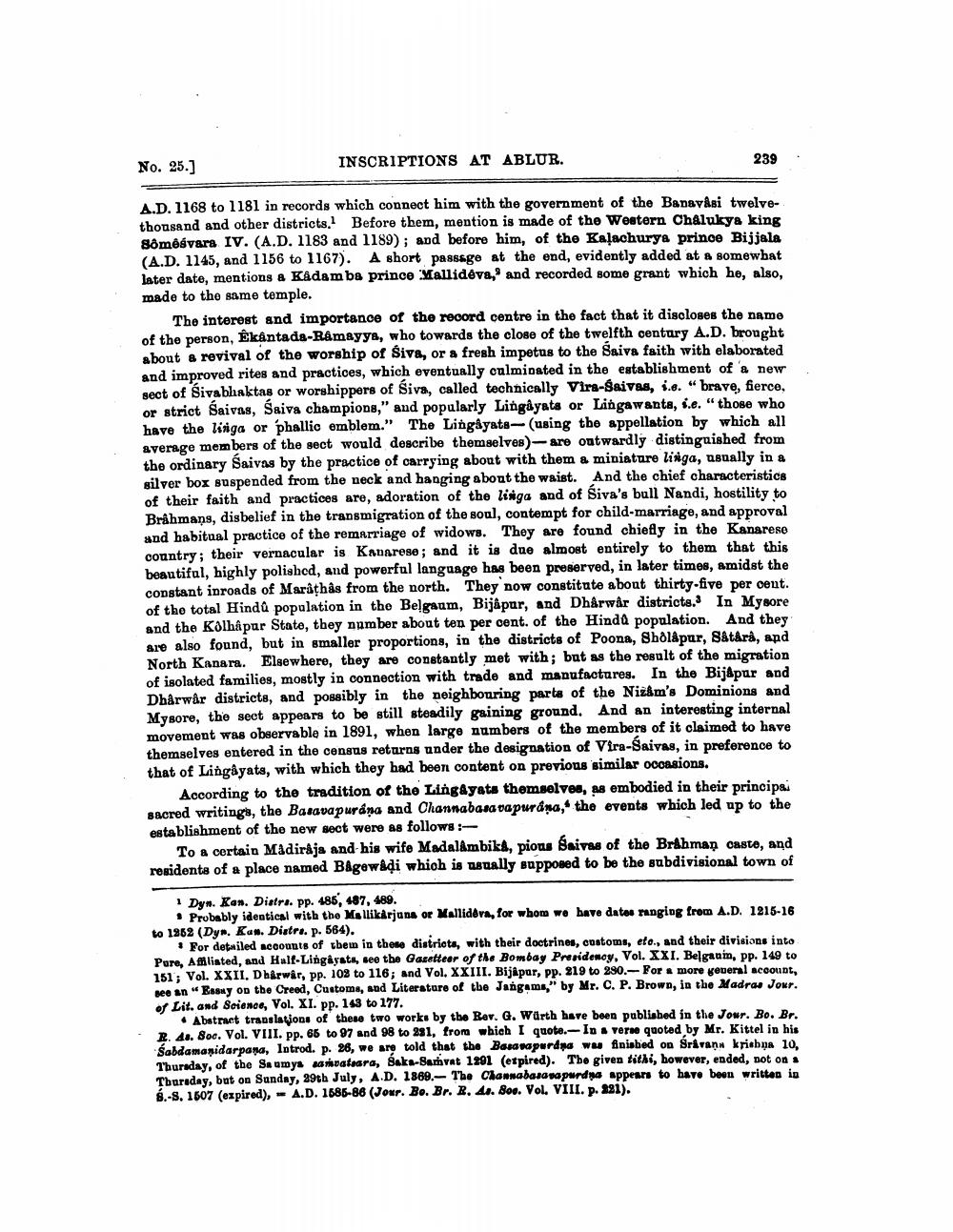________________
No. 25.]
INSCRIPTIONS AT ABLUR.
239
.
A.D. 1168 to 1181 in records which connect him with the government of the BanayAsi twelvethousand and other districts. Before them, mention is made of the Western Chalukya king Hômêsvars IV. (A.D. 1183 and 1189); and before him, of the Kalachurya prince Bijjala (A.D. 1145, and 1156 to 1167). A short passage at the end, evidently added at a somewhat later date, mentions a Kadamba prince Mallideva,' and recorded some grant which he, also, made to the same temple.
The interest and importance of the record centre in the fact that it discloses the name of the person, Ékantada-Råmeyye, who towards the close of the twelfth century A.D. brought about & revival of the worship of Siva, or a fresh impetus to the Saiva faith with elaborated and improved rites and practices, which eventually culminated in the establishment of a new sect of Sivabhaktas or worshippers of Siva, called technically Vira-Saivas, 1.6. "brave, fierce, or strict Saivas, Saiva champions," and popularly Lingayats or Lingawanta, s.e. "those who have the litiga or phallic emblem." The Lingayats-(using the appellation by which all average members of the sect would describe themselves) - are outwardly distinguished from the ordinary Saivas by the practice of carrying about with them a miniature linga, usually in a silver box suspended from the neck and hanging about the waist. And the chief characteristics of their faith and practices are, adoration of the linga and of Siva's bull Nandi, hostility to Brahmans, disbelief in the transmigration of the soul, contempt for child marriage, and approval und habitual practice of the remarriage of widows. They are found chiefly in the Kanarese country; their vernacular is Kanarese; and it is due almost entirely to them that this beautiful, highly polished, and powerful language has been preserved, in later times, amidst the constant inroads of Marấthâs from the north. They now constitute about thirty-five per cent. of the total Hindų population in the Belgaum, Bijapur, and Dharwar districts. In Mysore and the Kolhapur State, they number about ten per cent. of the Hindů population. And they are also found, but in smaller proportions, in the districts of Poona, Sholapur, S&tara, and North Kanara. Elsewhere, they are constantly met with ; but as the result of the migration of isolated families, mostly in connection with trade and manufactures. In the Bijapur and Dharwar districts, and possibly in the neighbouring parts of the Nizam's Dominions and Mysore, the sect appears to be still steadily gaining ground. And an interesting internal movement was observable in 1891, when large numbers of the members of it claimed to have themselves entered in the census retarns under the designation of Vira-Saivas, in preference to that of Lingayats, with which they had been content on previous similar cocasions.
According to the tradition of the Lingayats themselves, as embodied in their princips. sacred writings, the Basavapurana and Channabasa tapurana," the events which led up to the establishment of the new sect were as follows:
To a certain Madiraja and his wife Madalambika, pious Baivas of the Brahman caste, and residents of a place named Bagewadi which is usually supposed to be the subdivisional town of
Dyn. Kan. Distr. pp. 485, 487, 489.
• Probably identical with the Mallikarjana or Mallideva, for whom we have dates ranging from A.D. 1215-16 to 1962 (Dyr. Kas. Distr. p. 564).
For detailed accounts of them in these districts, with their doctrines, customs, eto., and their divisions into Pore, Afiliated, and Half-Lingayata, see the Gazetteer of the Bombay Presidency, Vol. XXI. Belgaum, pp. 149 to 151; Vol. XXII, Dharwar, pp. 102 to 116; and Vol. XXIII. Bijapur, pp. 219 to 280.- For more general account, Me an Essay on the Creed, Customs, and Literature of the Jangams," by Mr. C. P. Brown, in the Madrau Jour. of Lit. and Science, Vol. XI. pp. 143 to 177.
Abstract translations of these two works by the Rev. G. Warth have been published in the Jour. Bo. Br. R. 41. Soc. Vol. VIII. pp. 66 to 97 and 98 to 281, from which I quote.--Ins verre quoted by Mr. Kittel in his Sabdamanidarpana, Introd. p. 26, we are told that the Basanapurdina wae finisbed on Sriranu kriebna 10. Thursday, of the Seamys aanvatara, Saka-Samyat 1291 (expired). The given tithi, however, ended, not on a Thursday, but on Sunday, 29th July, A.D. 1869.- The Channabasasapurda appears to have been written in 6.-S. 1607 (expired), - A.D. 1685-86 (Jour. Be. Br. B. 41. 806. Vol. VIII. p. 291).




